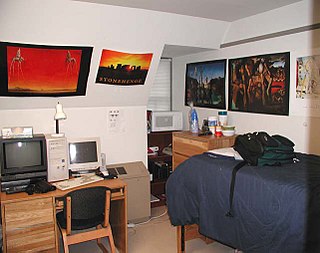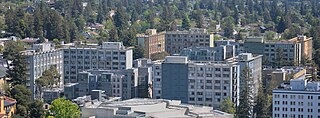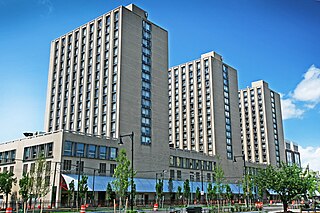
Huntington is a city in Cabell and Wayne counties in the U.S. state of West Virginia. The seat of Cabell County, the city is located in SW West Virginia at the confluence of the Ohio and Guyandotte rivers. The population was 46,842 at the 2020 census. According to 2023 census estimates, the city is estimated to have a population of 45,325. Huntington is the second-most populous city in West Virginia. Its metro area, the Huntington–Ashland metropolitan area, is the largest in West Virginia, spanning seven counties across three states and having a population of 368,262 at the 2023 estimate.

A dormitory, also known as a hall of residence or a residence hall, is a building primarily providing sleeping and residential quarters for large numbers of people such as boarding school, high school, college or university students. In some countries, it can also refer to a room containing several beds accommodating people.

Marshall University is a public research university in Huntington, West Virginia, United States. It was founded in 1837 and is named after John Marshall, the fourth chief justice of the United States. The university is classified among "R2: Doctoral Universities – High research activity".

Housing at the University of California, Berkeley, includes student housing facilities run by the office of Residential and Student Service Programs (RSSP). Housing is also offered by off-campus entities such as fraternities and sororities and the Berkeley Student Cooperative (BSC).

The Boston University housing system is the 2nd-largest of any private university in the United States, with 76% of the undergraduate population living on campus. On-campus housing at BU is an unusually diverse melange, ranging from individual 19th-century brownstone town houses and apartment buildings acquired by the school to large-scale high-rises built in the 60s and 2000s.

Myles Standish Hall is a Boston University dormitory located at 610 Beacon Street, in Kenmore Square. Originally constructed in 1925 and opened as the Myles Standish Hotel, it was deemed to be one of the finest hotels in the world. In 1949 BU acquired the building and converted it into a dormitory.

Pullman Square is a lifestyle center in downtown Huntington, West Virginia, United States between 8th and 10th Street and 3rd Avenue and Veteran's Memorial Boulevard. It is located on what was known as the Superblock, a large urban renewal project that saw the demolishing of four city-square-blocks in 1970. The center opened in 2004, featuring approximately 20 stores, along with office space, restaurants, and a movie theater. It was developed by Metropolitan Partners.

The Marshall Recreation Center at Marshall University is located at 5th Avenue and 20th Street in Huntington, West Virginia. The complex is part of a $95 million expansion plan that includes two new "living-learning" residence halls

Court–Kay–Bauer Community (CKB) is a group of freshman residence halls on Cornell University's North Campus opened to Cornell students in the fall of 2001. The building was first named Court Hall for the dormitory’s formation of a courtyard enclosed on the opposite side by Clara Dickson Hall. On October 14, 2005, the southern wing of Court Hall was renamed Bauer Hall in response to a gift of $10 million to the University by Robert and Virginia Bauer. On October 12, 2006, the middle wing of Court Hall was renamed Kay Hall, also in response to a donation of $10 million by Bill Kay. Court-Kay-Bauer Halls, as well Mews Hall, were built as a part of the North Campus Housing Initiative, and are being renamed in order to fund construction of new upper-classmen residence halls on Cornell’s West Campus. The money generated from the renaming of Court Hall has been put towards the estimated $248 million development of West Campus. Bauer Hall is the section south of the bridge, Kay Hall is the section north of the bridge, and Court Hall is the section perpendicular to Kay Hall.
Cabell Huntington Hospital is a regional, 303-bed academic medical center located in Huntington, West Virginia. Cabell Huntington cares for patients from more than 29 counties in West Virginia, eastern Kentucky, and southern Ohio. It is one of the ten largest general hospitals in West Virginia. Opened in 1956, it is also a teaching hospital and is affiliated with the Marshall University Joan C. Edwards School of Medicine, School of Nursing, and School of Pharmacy. The hospital is also home to the Edwards Comprehensive Cancer Center, a three-story facility that opened in 2006.
James Howard Harless, better known as Buck Harless, was an American coal and timber operator and philanthropist, who was renowned in the area of his hometown of Gilbert, West Virginia, for his extensive contributions to schools, churches, healthcare and education programs.
Guyandotte is a historic neighborhood in the city of Huntington, West Virginia, that previously existed as a separate town before annexation was completed by the latter. The neighborhood is home to many historic properties, and was first settled by natives of France at the end of the eighteenth century. Guyandotte was already a thriving town when the state of West Virginia was formed from part of Virginia. Located at the confluence of the Guyandotte River and the Ohio River, it was already a regional trade center with several industries of its own when the Chesapeake and Ohio Railway (C&O) reached its western terminus nearby just across the Guyandotte River in 1873. This event was soon followed by the formation and quick development of the present city of Huntington which was named in honor of the C&O Railway's founder and then principal owner Collis P. Huntington.
The McCormick Road Dormitories are one of two main areas of first-year living dormitories at the University of Virginia, the other being the Alderman Road Dormitories. Ten houses make up the residence area located on McCormick Road. The dormitory area was constructed in 1950 and holds nearly 1300 students. Although older and lacking in modern amenities compared to "New Dorms," Old Dorms are closer to Central Grounds and contain larger rooms.
Mountwest Community and Technical College (MCTC) is a public community college in Huntington, West Virginia. It is part of the West Virginia Community and Technical College System. The college offers associate degree programs including several career courses in maritime through its Inland Waterways Academy.
The Joan C. Edwards School of Medicine is the medical school of Marshall University in Huntington, West Virginia. It is one of three medical schools in the state of West Virginia.
The Guyandotte River train wreck occurred on the morning of January 1, 1913, when the Chesapeake and Ohio Railway's (C&O) train No. 99, scheduled to run from Hinton, West Virginia, to Russell, Kentucky, and headed by Mikado locomotive 820, fell through a bridge over the Guyandotte River near Huntington, West Virginia while attempting to cross it. The accident killed seven people.

Old Huntington High School is a historic high school building located at Huntington, Cabell County, West Virginia. It was built in 1916, and is a 4+1⁄2-story buff-brick building in the Classical Revival style. It consists of a long rectangle with a shorter rectangular wing on each end of the main rectangle forming a "U" shape. The courtyard is enclosed with three additions completed in 1951 (gymnasium), 1956 (cafeteria), and 1977. The building contains 155,512 square feet (14,447.5 m2) of space. The kitchen is located in an older red brick building built in 1916, built originally as a carriage house. The last graduating class was in 1996. A new facility was built to consolidate Old Huntington High and Huntington East High School into a single institution; the new school opened in August 1996 as Huntington High School. It is now known as The Renaissance Center. Part of the building was converted into apartments. The YMCA uses part of it for workout facilities and a daycare facility. The building also houses studio space, an auditorium, and small art gallery.

The Alderman Road Dormitories are one of two main areas of first-year living dormitories at the University of Virginia, the other being the McCormick Road Dormitories. There were originally eleven houses in the residence area located on Alderman Road, which were constructed in the early 1960s to accommodate a large growth in admitted students. In 2006, the University initiated a replacement project after determining that renovating the dormitories would be less cost effective and would not provide more beds for projected enrolment growth. Additionally, the University wants to provide modern amenities for its first year students. The project, which is split into four phases, were finished by 2015.
Stony Brook University is the largest residential campus in the State University of New York system, with approximately 54.5% of its students living on campus. Housing at Stony Brook is issued and controlled by Stony Brook University Campus Residences, which provides 9,445 spaces in its 11 corridor style buildings, 19 suite style buildings, and 23 apartment style buildings to Undergraduate students, Graduate students, and students' families. The large majority of on-campus housing is provided to students on the university's west campus, but housing is available to those on east campus, and for Stony Brook Southampton students.












